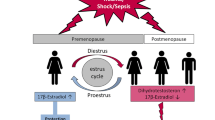Abstract
Objective: Laboratory studies demonstrated significant detrimental effects of male sex-steroids (testosterone) on immune functions following hemorrhagic shock and soft-tissue trauma. Moreover, better survival of female mice subjected to severe sepsis was observed when compared to male animals. The aims of the present study were to evaluate whether or not gender differences regarding incidence and mortality of severe sepsis do exist in surgical intensive care patients and to elucidate the influence of patient age on incidence and mortality of severe sepsis/septic shock.¶Design: Data base review of prospectively collected data from surgical intensive care patients.¶Setting: Surgical intensive care unit of the department of surgery of a university hospital.¶Patients: Prospectively collected data of 4218 intensive care patients (2709 male, 1509 female).¶Results: Significantly fewer female patients were referred to the intensive care unit (6.6 % vs 10.8 % of all patients; P < 0.05) leading to a significantly smaller proportion of female intensive care patients (35.8 % vs 64.2 %). No gender differences regarding number of failing organs or surgical procedure (exception vascular surgery) were observed in patients with and without severe sepsis/septic shock, indicating that the patients studied are comparable regarding general health prior to admission to SICU. Among all female patients referred to SICU only 7.6 % developed severe sepsis/septic shock, while 10.4 % of all male patients suffered from severe sepsis or septic shock (P < 0.05). This gender difference results from a significantly lower incidence of severe sepsis/septic shock in female patients between 60 and 79 years. No gender difference regarding mortality rates of severe sepsis/septic shock was observed (men 64.9 %, women 65.5 %).¶Conclusions: Our results indicate a significantly smaller number of female patients requiring intensive care as well as a significantly lower incidence of severe sepsis/septic shock in female intensive care patients. Mortality from severe sepsis/septic shock, however, is not affected by gender.
Similar content being viewed by others
Author information
Authors and Affiliations
Additional information
Received: 23 March 1999 Final revision received: 1 October 1999 Accepted: 19 November 1999
Rights and permissions
About this article
Cite this article
Wichmann, M., Inthorn, D., Andress, HJ. et al. Incidence and mortality of severe sepsis in surgical intensive care patients: the influence of patient gender on disease process and outcome. Intensive Care Med 26, 167–172 (2000). https://doi.org/10.1007/s001340050041
Issue Date:
DOI: https://doi.org/10.1007/s001340050041




